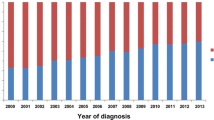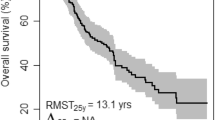Summary
Several putative prognostic factors have been identified in node-positive breast cancer patients, but their importance needs to be clarified in a uniformly treated population. The objectives of this investigation were: 1) to describe the characteristics of a uniformly treated node-positive data base; 2) to use proportional hazards (Cox) and recursive partitioning and amalgamation (RPA) multivariate models to assess the importance of potential prognostic factors for disease-free and for overall survival; and 3) to define prognostic groups with different disease-free survival and survival outcomes with RPA. A data base of 768 node-positive patients enrolled on 1-year adjuvant CMFVP arms of four SWOG trials was formed. Variables were number of positive nodes, age, age at menopause, menopausal status, ER status, ER and PgR levels (for RPA only), tumor size, race, breast cancer in mother, and obesity index. Independent predictors of both disease-free and overall survival in the Cox models were: number of positive nodes (4–6 worse than 1–3, and better than >6); the age/menopause category (age≥35/premenopausal better than age<35/premenopausal and better than postmenopausal); and ER status (patients on ER-negative study worse than others). The RPA for disease-free survival defined four subgroups based on nodes, menopausal status, tumor size, and age at menopause (5-year recurrence-free rates=73%, 52%, 38%, and 15%). The RPA for survival found four prognostic groups, defined only by the number of positive nodes and ER and PgR levels (5-year survivals=91%, 72%, 56%, and 37%). Both RPAs suggested interesting refinements of the results of the Cox models. In the RPA for disease-free survival, best node cutoffs differed by menopausal status, tumor size was important only in postmenopausal patients with few positive nodes, and age at menopause emerged as an independent predictor of recurrence potential. And, the RPA for survival showed that node cutoffs differed according to ER level. Thus, these analyses underscore the value of simple, clinically available prognostic factors and suggest the possible need to reconsider the definition of good and poor risk patient groups in future adjuvant trial design.
Similar content being viewed by others
References
Fisher ER: Prognostic and therapeutic significance of pathological features of breast cancer. NCI Monogr 1:29–34, 1986.
Valagussa P, Bonadonna G, Veronesi U: Patterns of relapse and survival following radical mastectomy. Analysis of 716 consecutive patients. Cancer 41:1170–1178, 1978.
Cascinelli N, Greco M, Bufalino R, Clemente C, Galluzzo D, delle-Donne V, de Lellis R, Sacchini B, Veronesi U: Prognosis of breast cancer with axillary node metastases after surgical treatment only. Eur J Cancer Clin Oncol 23:795–799, 1987.
Henderson IC: Adjuvant systemic therapy for early breast cancer. Curr Probl Cancer 11:125–207, 1987.
Albain KS: Adjuvant chemotherapy and endocrine therapy for node-positive and node-negative breast carcinoma. Clin Obstet Gynecol 32:835–857, 1989.
Stewart JA, Foster RS: Breast cancer and aging. Semin Oncol 16:41–50, 1989.
Holmes FF: Clinical evidence for a change in tumor aggressiveness with age. Semin Oncol 16:34–40, 1989.
Adami H, Malker B, Holmberg L, et al: The relation between survival and age at diagnosis in breast cancer. N Engl J Med 315:559–563, 1986.
Fisher B, Redmond CK, Wolmark W, et al: Long term results from NSABP trials of adjuvant therapy for breast cancer.In Salmon SE (ed) Adjuvant Therapy of Cancer, Vol V. Grune & Stratton, Philadelphia, 1987, p 283.
Bonadonna G, Valagussa P, Zambetti M, et al: Milan adjuvant trials for stage I-II breast cancer.In Salmon SE (ed) Adjuvant Therapy of Cancer, Vol V. Grune & Stratton, Philadelphia, 1987, p 211.
Osborne CK: Receptors.In Harris JR, Hellman S, Henderson IC, Kinne DW (eds) Breast Diseases. J.B. Lippincott, Philadelphia, 1987, p 210.
Rivkin SE, Green S, Metch B, Glucksberg H, Gad-el-Mawla N, Costanzi JL, Hoogstraten B, Athens J, Maloney T, Osborne CK, Vaughn CB: Adjuvant CMFVP versus melphalan for operable breast cancer with positive axillary nodes: 10-year results of a Southwest Oncology Group Study. J Clin Oncol 7: 1229–1238, 1989
Tormey DC, Gray R, Gilchrist K, Grage T, Carbone PP, Wolter J, Woll JE, Cummings FJ: Adjuvant chemohormonal therapy with cyclophosphamide, methotrexate, 5-fluorouracil, and prednisone (CMFP) or CMFP plus tamoxifen compared with CMF for premenopausal breast cancer patients: an Eastern Cooperative Oncology Group Trial. Cancer 65:200–206, 1990.
Chevallier B, Asselain B, Braic Y, Dauce JP, Bastit P, Centre H: The prognostic value of patient age at initial diagnosis of operable breast cancer: implications for neoadjuvant chemotherapy? Proc 2d Int Congr Neoadj Chemother, p 76, 1988.
Alexieva-Figusch J, van Putten WLJ, Blankenstein MA, Blonk-van der Wijst J, Klijn JGM: The prognostic value and relationships of patient characteristics, estrogen and progestin receptors, and site of relapse in primary breast cancer. Cancer 61:758–768, 1988.
Camoriano JK, Loprinzi CL, Ingle JN, Therneau TM, Krook JE, Veeder MH: Weight change in women treated with adjuvant therapy or observed following mastectomy for node-positive breast cancer. J Clin Oncol 8:1327–1334, 1990.
Tormey DC, Veinberg VE, Holland JF, Weiss RB, Glidewell OJ, Perloff M, et al, for the CALGB: A randomized trial of five and three drug chemotherapy and chemoimmunotherapy in women with operable node positive breast cancer. J Clin Oncol 1:138–145, 1983.
Slamon DJ, Clark GM, Wong SG, Levin WJ, Ullrich A, McGuire WL: Human breast cancer: correlation of relapse and survival with amplification of the HER-2/neu oncogene. Science 235:177–181, 1987.
Silvestrini R, Daidone MG, Valagussa P, DiFronzo G, Mezzanotte G, Mariani L, Bonadonna G:3H-thymidine-labeling index as a prognostic indicator in node-positive breast cancer. J Clin Oncol 8:1321–1326, 1990.
Fisher B, Fisher ER, Redmond C, for the NSABP: Ten-year results from the NSABP clinical trial evaluating the use of 1-phenylalanine mustard in the management of primary breast cancer. J Clin Oncol 4:929–941, 1986.
Davis BW, Gelber RD, Goldhirsch A, Hartmann WH, Locher GW, Reed R, et al, for the Ludwig Breast Cancer Study Group: Prognostic significance of tumor grade in clinical trials of adjuvant therapy for breast cancer with axillary lymph node metastasis. Cancer 58:2662–2670, 1986.
Green S, Rivkin S, Metch B, Osborne CK, Cruz A, Balcerzak S, Stevens R, Costanzi J, for the Southwest Oncology Group: Adjuvant chemotherapy for poor prognosis estrogen receptor negative stage II-III breast cancer: A comparison of one year vs. two years of CMFVP [abstract]. Proc Am Soc Clin Oncol 8:24, 1989.
Rivkin S, Green S, Metch B, Cruz A, Tesh D, Glick J, Knight W, Osborne CK: Adjuvant combination chemotherapy (CMFVP) vs. oophorectomy followed by CMFVP for premenopausal women with ER-positive operable breast cancer with positive axillary lymph nodes: an Intergroup study [abstract]. Proc Am Soc Clin Oncol 10:47, 1991.
Rivkin S, Green S, Metch B, Cruz A, McDivitt R, Knight W, Glick J, Osborne CK: Adjuvant combination chemotherapy (CMFVP) vs. tamoxifen vs. CMFVP plus tamoxifen for postmenopausal women with ER-positive operable breast cancer and positive axillary lymph nodes: an Intergroup study [abstract]. Proc Am Soc Clin Oncol 9:24, 1990.
Kaplan EL, Meier P: Nonparametric estimation from incomplete observations. J Am Statist Assoc 53:457–481, 1958.
Mantel N: Evaluation of survival data and two new rank order statistics arising in its consideration. Cancer Chemother Rep 50:163–170, 1966.
Cox DR: Regression models and life tables. J Roy Statist Soc [Series B] 34:187–220, 1972.
Breiman L, Friedman JH, Olshen RA, et al: Classification and Regression Trees. Wadsworth, Belmont CA, 1984.
Ciampi A, Thiffault J: Recursive partitioning and amalgamation (RECPAM) for censored survival data: Criteria for tree selection. Statistical Software Newsletter 14:78–81, 1988.
LeBlanc M: Recursive Partitioning for Censored Survival Data [doctoral dissertation]. University of Washington, Seattle WA, 1989.
Albain KS, Crowley JJ, LeBlanc M, Livingston RB: Determinants of improved outcome in small cell lung cancer: an analysis of the 2,580-patient Southwest Oncology Group data base. J Clin Oncol 8:1563–1574, 1990.
Albain KS, Crowley JJ, LeBlanc M, Livingston RB: Survival determinants in extensive stage non-small cell lung cancer: The Southwest Oncology Group experience. J Clin Oncol 9:1618–1626, 1991.
Author information
Authors and Affiliations
Rights and permissions
About this article
Cite this article
Albain, K.S., Green, S., LeBlanc, M. et al. Proportional hazards and recursive partitioning and amalgamation analyses of the southwest oncology group node-positive adjuvant CMFVP breast cancer data base: a pilot study. Breast Cancer Res Tr 22, 273–284 (1992). https://doi.org/10.1007/BF01840840
Issue Date:
DOI: https://doi.org/10.1007/BF01840840




